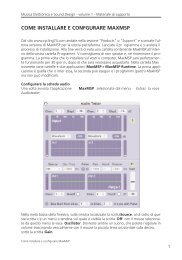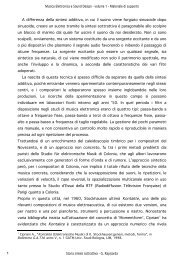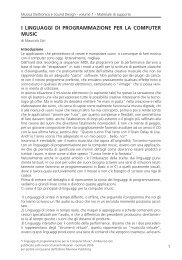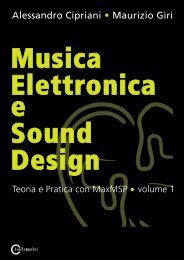programming with max/msp - Virtual Sound
programming with max/msp - Virtual Sound
programming with max/msp - Virtual Sound
You also want an ePaper? Increase the reach of your titles
YUMPU automatically turns print PDFs into web optimized ePapers that Google loves.
Chapter 4T - Control signals<br />
4.1 CONTROL SIGNALS: STEREO PANNING<br />
As we have seen throughout this book, envelope generators can be used to vary<br />
the parameters of a sound, such as frequency or amplitude, in time. Signals that<br />
come from envelope generators – signals that are expressly produced to vary<br />
parameter values rather than to produce sound – are called control signals.<br />
To this point, we have used line segments and exponential curves to describe<br />
control signals. These techniques are efficient because they require only a few<br />
values to describe parameter changes; think of the four segments that we use<br />
for ADSR envelopes, or of the numbers that define an exponential curve, which<br />
can completely describe a glissando. Other control signals, however, may need<br />
to vary in more complex ways. Take the vibrato associated <strong>with</strong> a string instrument<br />
as an example: there is a continuous change in the frequency of a note<br />
played <strong>with</strong> vibrato that can best be described as an oscillation around a central<br />
pitch. To simulate such a vibration using an envelope, we might need to use<br />
tens, or even hundreds, of line segments, which would be both tedious and<br />
impractical. Instead of resorting to such primitive methods, we might instead<br />
choose to use a control oscillator, an oscillator whose output is produced for<br />
the sole purpose of providing parameter values to audio oscillators or other<br />
parameterized devices used in sound synthesis and signal processing.<br />
Control oscillators are usually Low Frequency Oscillators (LFOs); their<br />
frequency is usually below 30 Hz. They produce continuously changing control<br />
values that trace waveforms in the same way that audio oscillators do. Every<br />
instantaneous amplitude of a wave generated by a control oscillator corresponds<br />
to a numeric value that can be applied to audio parameters as needed.<br />
Here is an example demonstrating the use of an LFO: in Figure 4.1, you see a<br />
graphic representation of an LFO controlling the position of a sound in space.<br />
This LFO generates a sine wave that oscillates between MIN (representing its<br />
minimum value) and MAX (its <strong>max</strong>imum value).<br />
���<br />
���<br />
���<br />
�� �� �� ��<br />
Fig. 4.1 An LFO for controlling the position of a sound in space<br />
The minimum and <strong>max</strong>imum values, or the depth of the oscillator, define the<br />
limits of the amplitude values being produced, while the rate of the oscillator<br />
is a value that defines its frequency.<br />
from “Electronic Music and <strong>Sound</strong> Design” Vol. 1 by Alessandro Cipriani and Maurizio Giri<br />
© ConTempoNet 2010 - All rights reserved<br />
4T<br />
473







